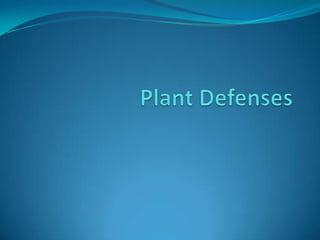
Plant defenses
- 2. Types of Plant Defenses Constitutive The defense is always present in the plant Inducible The defenses that a are produced when a plant is injured or detects foreign pathogen
- 3. Constitutive Defenses Cell walls Prevent the pathogens from entering the cell Waxy epidermal cuticle Prevent water loss and micro bacterial from entering epidermal
- 4. Constitutive Defenses Bark Keeps pathogens and insects from going to the living cells underneath the bark Thorns Reduce feeding by large herbivores by limiting the feeding rate.
- 5. Inducible Defenses Toxic chemicals Pathogen degrading enzymes Deliberate cell suicide
- 6. Secondary Compounds Examples Methol Linalool- used as an anesthetic Carotene- used as an antioxidant and for orange coloring Altropine-used to treat motion sickness Scopolamine- used to treat motion sickness Sennoside- used as a laxative
- 7. Secondary Compounds Secondary compounds have negative impacts on herbivores and pathogens They are toxic to herbivores and microbes The production of the compounds is increased when being attacked by a herbivore or a pathogen
- 8. Plants and Herbivore co-evolution Silica-rich grass Toxic Chemicals Different tooth structures and special enzymes to digest the plants Let fungi and bacteria weaken the plant defenses Enzymes to reduce toxins, eat clay and other minerals to reduce poison
- 9. References Brian C. Freeman and Gwyn A. Beattie. 2011. An Overview of Plant Defenses against Pathogens and Herbivores. APSnet. http://www.apsnet.org/edcenter/intropp/topics/Pages/OverviewOfPlantDiseases.aspx. 1/24/2011. Campbell, Reece, Urry, Cain, Minorsky, Wasserman. 2008. Biology. 8th Edition. Pearson. See pages 845-846. Wise Geek. 2011. What are Some Herbivore Adaptations to Plant Defense. Wise Geek. http://www.wisegeek.com/what-are-some-herbivore-adaptation-to-plant-defense.htm. 1/24/2011 Molecular Expressions. 2010. Plant Cell Structure. Molecular Expressions. http://micro.magnet.fsu.edu/cells/plantcell.html. 1/24/2011. Campus Arboretum. 2080. Pinus Project. Campus Arboretum. http://arboretum.arizona.edu/id_halepensis.html. 1/24/2011. The San Diego Zoo. 2010. Pandas. Solcomhouse. http://www.solcomhouse.com/pandas.htm. 1/27/2011. Animal-World. 2011. Aquarium Plant Substrates. Animal-World. http://animal-world.com/encyclo/fresh/plants/PlantSubstrates.htm. 1/24/2011 Novel Guide. 2011. Medical Plants. Novel Guide. http://www.novelguide.com/a/discover/plsc_03/plsc_03_00202.html. 1/24/2011